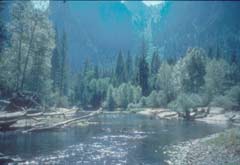 Riparian zone in Yosemite. (Photo credit: Wikipedia)
Riparian zone in Yosemite. (Photo credit: Wikipedia)
What do you know about Dippers? I, myself, have seen them a few times out on the local streams and all I knew about them is that they… well, they “dip”.
At the final Aspen Center for EnvironmentalStudies (ACES) Naturalist Nights presentation of the season, I found out also that, like us, they are always on the lookout for a good “neighborhood” in which to live. They are an indicator of river health because, in their quest to find the best places to nest and feed, they look for the same ecological characteristics that biologists/naturalists deem vital to healthy stream and riparian areas.
During the presentation, “The American Dipper as an Indicator of River Health”, Dee Malone with the Roaring Fork Conservancy, related that Dippers, which are Aspen’s only aquatic songbird, are habitat specialists – they occupy only healthy, fast-flowing mountain streams and their adjacent riparian areas. They seek out habitat close to the water in locations that are protected from floods, are in a natural flow regime, and are inaccessible to predators (often in areas covered by riparian foliage).
They eat mostly invertebrates such as the larvae or immature forms (nymphs) of certain species of mayflies and caddisflies found among the rocks and debris in and along rapidly-moving, cold streams. These invertebrates do not tolerate chemical, thermal, or sediment pollution and require healthy streams and vibrant riparian zone areas in order to survive.
According to Dee , a healthy stream has these attributes:
According to Dee , a healthy stream has these attributes:
- they support, long-term, a full compliment of native wildlife species
- they contain clear, unpolluted water (not too hot, lots of oxygen -- which requires fast moving water – i.e. riffles, and not too much sediment)
- the adjacent riparian zone needs to have foliage that provides shade for the streams to keep the water cool, and which upon shedding leaves releases the nutrients on which the invertebrates feed.
- the root structures from the riparian zone must stabilize the banks, keeping sediment low and preventing “upland” pollutants from reaching the stream
Dee also revealed that climate change in the area, as evidenced by increasingly earlier occurrences of annual stream de-icing and spring runoff, is resulting in earlier spring floods and reduced mid and late-summer stream flow. This is believed to inhibit the stream's and adjacent riparian zone's ability to avoid unacceptable amounts of stream pollution, thus affecting the availability of the Dippers’ food supply.
Furthermore, the Dippers’ breeding cycle is synchronized with this stream de-icing and spring runoff, and although Dippers have evolved in such a way as to have their young developed enough to survive and feed in the high runoff water, the changing timing of this cycle in some areas may no longer allow their offspring to be sufficiently mature to survive this annual event.
In response to this, the Dippers will eventually move on.
It seems that, just like humans, Dippers are always on the lookout for a favorable neighborhood in which to live, and their disappearance from a given territory might be a strong indicator of overall poor stream and riparian zone health in that area.
It seems that, just like humans, Dippers are always on the lookout for a favorable neighborhood in which to live, and their disappearance from a given territory might be a strong indicator of overall poor stream and riparian zone health in that area.
To view recent Naturalist Nights presentations, visit The Wilderness Workshop’s website. - http://www.wildernessworkshop.org/news.html?page=287

No comments:
Post a Comment